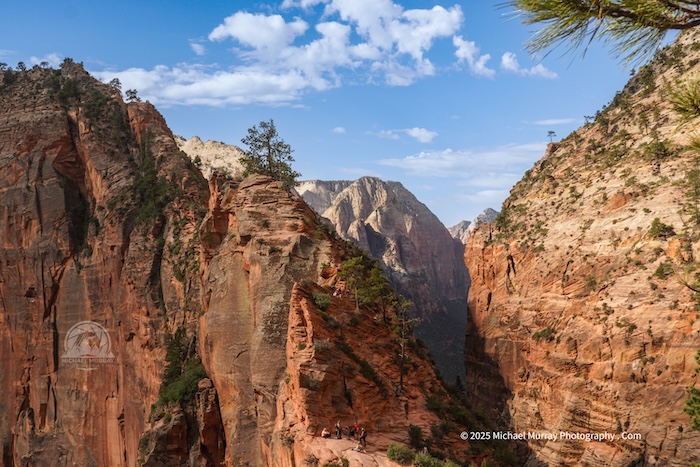Angels Landing Photo Zion National Park in Utah
Scout Lookout and the beginning of the challenging trail with chained sections and sheer cliff drop-offs
Add this picture to your home or office decor.
High resolution image is available in multiple sizes (no watermarks). Interested? Send an email to [email protected]

The photo of Angel’s Landing in Zion National Park is one that immediately commands attention. In this wide view, the picture captures the beginning of the world-famous Angel’s Landing trail, where sheer cliff edges hug the path and a dramatic drop lies just inches away. At first glance, the image can be intimidating—the scale of the cliffs is overwhelming, and the people visible in the frame provide a stark sense of just how massive this landscape truly is. With Scout Lookout in the distance, the photo reflects not only the natural beauty of Zion but also the thrilling challenge that has made this hike one of the most iconic in the national park system.
This is more than just a casual walk through nature. Angels Landing is consistently ranked among the most dangerous trails in America, a place where even confident hikers feel their knees shake. The picture reminds us of this reality: narrow sandstone ridges, chains bolted into the rock for safety, and the ever-present awareness of a sheer drop just beyond your boots. The image allows the viewer to feel that same mix of awe and fear, even from the safety of home.
Zion National Park itself is known for its towering cliffs, winding canyon walls, and lush valleys, but Angels Landing stands apart as a test of both physical endurance and mental resolve. The photo shows just the first stretch, yet already the path feels daunting. The people in the picture, small against the immense cliffs, demonstrate the enormity of the rock formation. From this perspective, you see why many hikers describe the journey as terrifying—one wrong step could mean disaster. Still, thousands line up each day to attempt it, drawn by the promise of unbeatable views and the thrill of achievement.
Scout Lookout, included in this wide-angle image, serves as a kind of resting point. For many hikers, reaching Scout Lookout is enough—an accomplishment in itself without venturing onto the final, narrow spine of Angel’s Landing. The photo captures this transition zone: a place where visitors decide if they are ready to face the last, most dangerous section. The sheer exposure of the trail beyond is not for the faint of heart. Some turn back, choosing safety over risk, while others grip the chains tightly and push forward, hearts racing.
The picture also highlights the communal nature of the experience. You can see groups of people spread out along the trail, reminding us that this is one of the most popular attractions in Zion. Despite the danger, the crowds reflect just how magnetic Angel’s Landing is. For many, it’s a bucket-list hike, a story to tell, and a memory that will never fade. The photo conveys that popularity while also hinting at the nervous energy that accompanies so many visitors.
What makes the photo truly powerful is its ability to combine beauty with danger. The sandstone cliffs glow under the light, showing off the rich textures and colors of the canyon. Yet the trail itself remains a razor’s edge, a place where fear and wonder collide. The image does not hide the risks—instead, it showcases them, reminding us that nature is both breathtaking and unforgiving.
For those who have hiked Angel’s Landing, this picture will stir vivid memories: the tight grip on chains, the sound of the wind against the cliffs, the dizzying view looking down into the canyon. For those who have not yet attempted it, the photo serves as both invitation and warning. It is proof of why Angel’s Landing inspires awe, and why it can feel so daunting and terrifying.
Take Zion National Park home with you through this image of Angel’s Landing. It is more than just a picture; it’s a window into one of the most dramatic and dangerous hikes in the country. The photo embodies the thrill, the fear, and the breathtaking beauty of this remarkable landscape, ensuring the spirit of Zion lives on long after you’ve left the canyon walls behind